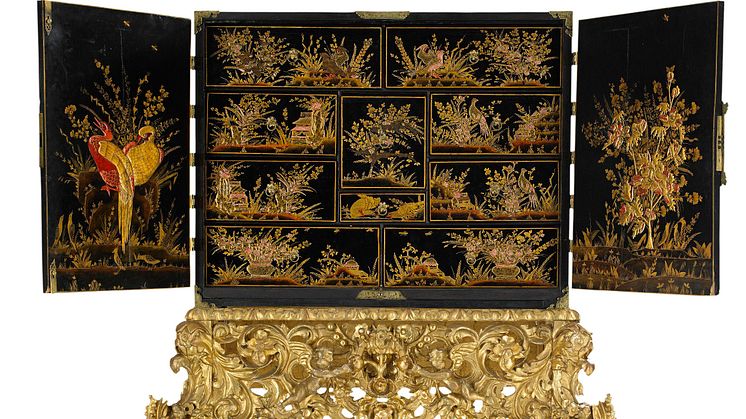
Press release -
New acquisition: English cabinet in imitation lacquer
Nationalmuseum has acquired a magnificent English cabinet in imitation lacquer. Manufactured circa 1680, the cabinet had been part of the Biby estate collection since 1788. Nationalmuseum purchased the piece at last summer’s auction of items from the Biby estate.
Nationalmuseum has added a splendid English piece with a proud Swedish heritage to its antique furniture collection. The cabinet had been part of the Biby estate collection, owned by the von Celsing family, since 1788. According to family tradition, it once belonged to the mill owner Johan Lohe (1643–1704). Via Lohe’s daughter and grandson, it passed into Gustaf Celsing’s ownership in 1781 as a result of a purchase. This lengthy Swedish pedigree shows that high-quality English furniture was being imported to Sweden as far back as the late 17th century.
Japanese and Chinese lacquer pieces were the height of fashion and were much sought after in Europe in the latter half of the 17th century. European craftsmen soon started imitating Oriental lacquer, but lacked the proper technical expertise and materials. The Oriental lacquer made from the sap of the urushi tree (Rhus vernicifera) is incredibly hard and water-resistant. European craftsmen had to rely on various shellac-based varnishes. In England, the dominant technique became known as “japanning”, alluding to the style’s geographical origins.
The cabinet acquired by Nationalmuseum is believed to have been made in London around 1680. Its upper part is entirely modelled on Japanese works in its form and ornamentation, while the underframe reflects the European baroque aesthetic with lavishly carved, gilded ornamentation. The square Japanese cabinets were originally intended to sit directly on the floor, but in Europe they were mounted on stands to match local furniture.
Nationalmuseum’s purchase of this English cabinet has been made possible by a generous bequest from Axel and Nora Lundgren. Nationalmuseum has no budget of its own for new acquisitions, but relies on gifting and financial support from private funds and foundations to enhance its collections of fine art and craft.
Press contacts
Anders Bengtsson, curator, applied art and design
anders.bengtsson@nationalmuseum.se, +46 8 5195 4385
Hanna Tottmar, press officer
hanna.tottmar@nationalmuseum.se, +46 767 234632
Caption
English cabinet in imitation lacquer, circa 1680. Photo: Stockholms Auktionsverk.
Categories
Nationalmuseum is Sweden’s premier museum of art and design. The collections comprise older paintings, sculpture, drawings and graphic art, and applied art and design up to the present day. The museum building is currently under renovation and scheduled to open again in 2017. In the meantime, the museum will continue its activities through collaborations both in Sweden and abroad as well as temporary exhibitions at the Royal Swedish Academy of Fine Arts, Fredsgatan 12, Stockholm. Nationalmuseum collaborates with Svenska Dagbladet, FCB Fältman & Malmén and Grand Hôtel Stockholm. For more information visit www.nationalmuseum.se.

